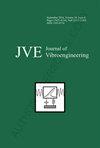Effect of train traction on the wheel polygonal wear of high-speed trains
IF 0.7
Q4 ENGINEERING, MECHANICAL
引用次数: 0
Abstract
High-order polygonal wear of wheels is one of the most severe technical challenges for China's high-speed trains at present, and its formation mechanism has not been thoroughly understood. The effect of train traction on the wheel polygonal wear of high-speed trains was studied based on a wheel/rail rolling contact finite element model. The frequency domain characteristics of unstable vibration of the wheel/rail system under rolling/sliding contact were studied by using the finite element complex modal analysis method. We also examined wheel/rail contact forces and friction in the time domain. The cause of the high-order polygonal wear of Chinese high-speed train wheels was revealed. The effect of the vehicle speed and the wheel diameter on wheel polygonal wear were investigated. The results show: the friction-induced vibration of the wheel/rail system will be excited when the rolling/sliding contact between the wheel and rail. The radial zoom modal of the wheel is an unstable mode, which is the main cause of the 21-22 order polygonal wear of the high-speed train wheels in China. Additionally, vehicle speed has a linear relationship with the order of polygonal wear. Reducing the vehicle speed helps to control the polygonal wear of the wheels. Wheels of different diameters exhibit varying degrees of polygonal wear, with smaller wheels being more resistant to friction-induced vibrations.列车牵引对高速列车车轮多边形磨损的影响
车轮高阶多边形磨损是目前中国高速列车面临的最严峻的技术挑战之一,其形成机理尚未得到深入研究。基于轮轨滚动接触有限元模型,研究了列车牵引对高速列车车轮多边形磨损的影响。利用有限元复模态分析方法研究了滚动/滑动接触下车轮/钢轨系统不稳定振动的频域特征。我们还在时域中研究了车轮/导轨接触力和摩擦力。揭示了中国高速列车车轮高阶多边形磨损的原因。研究了车速和车轮直径对车轮多边形磨损的影响。结果表明:当车轮与钢轨发生滚动/滑动接触时,会激发车轮/钢轨系统的摩擦诱导振动。车轮径向变焦模态是一种不稳定模态,是造成中国高速列车车轮 21-22 阶多边形磨损的主要原因。此外,车速与多边形磨损阶数呈线性关系。降低车速有助于控制车轮的多边形磨损。不同直径的车轮表现出不同程度的多边形磨损,较小的车轮更能抵抗摩擦引起的振动。
本文章由计算机程序翻译,如有差异,请以英文原文为准。
求助全文
约1分钟内获得全文
求助全文
来源期刊

Journal of Vibroengineering
工程技术-工程:机械
CiteScore
1.70
自引率
0.00%
发文量
97
审稿时长
4.5 months
期刊介绍:
Journal of VIBROENGINEERING (JVE) ISSN 1392-8716 is a prestigious peer reviewed International Journal specializing in theoretical and practical aspects of Vibration Engineering. It is indexed in ESCI and other major databases. Published every 1.5 months (8 times yearly), the journal attracts attention from the International Engineering Community.
 求助内容:
求助内容: 应助结果提醒方式:
应助结果提醒方式:


